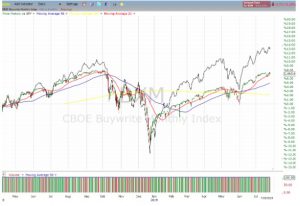With the major indices pushing to all-time highs and some of the many names sitting on large double-digit percentage gains, this year alone, it can be difficult to not only hold on but climb aboard even the bluest chip names like Amazon (AMZN) and Microsoft (MSFT) at this stage.
But, one strategy that helps overcome the psychological hurdle of buying new highs is the Buy-Write; buying shares and simultaneously selling call options against overwriting the stock.
The purpose of the buy-write is two-fold; it immediately reduced the effected cost basis or purchase price, and it helps generate some incremental income through the decay of the call’s premium you’ve collected.
But be warned, while this is a relatively simple strategy, especially if applied to just a handful of issues, it can be labor-intensive if one wants to expand the application to 50 stocks or even the full index, as it requires a considerable amount of time in selecting covered-call candidates. It also requires a fair amount of work maintaining and adjusting the positions. That, in turn, can lead to significant costs in the form of trading commissions and tax considerations.
There is also the very real downside that a buy-write approach could vastly underperform during periods of strong bull market. Like we have seen during the past few years. As you can see, despite the CBOE Buy-Write Index (BXM) steady and impressive 45% gain since 2017, it lags the SPY by some 15% points during that time period.

Here are some other issues to keep in mind when creating or investing in a buy-write (or even put selling strategy).
- These Are Both Labor- and Commission-Intensive Strategies. The two benchmarks are frictionless in that they do not account for any fees that will be accumulating by rolling positions 12 times a year. Expect a minimum of 1% annual drag on your performance.
- Volatility Levels Are an Essential Part of the Relative Returns. You can see from the table above that the best relative returns have come over the longer-term time horizons. This can be attributed to the “reversion to the mean” element of volatility levels. Obviously, the best time to establish premium-selling strategies would be when implied volatility is high; but that, of course, is a relative term. I think 2019 offers a nice balance of somewhat elevated implied volatility with a market trending moderately higher.
- Margining and Dividends. Depending on your account type, a covered call can be margined differently than a short put. Even though the PUT is based on a fully “cashed covered” positioned, the different margining would result in a different return on investment (RIO). Also, it’s important to be aware that a covered call, in which one owns the underlying security — this is true even of an ETF like the Spyder Trust SPY — will collect a dividend. While the expectations of a dividend are supposed to be embedded in the option’s price, in practical terms, the assurance of the steady income will often add a few basis points of return.
The Buy-Write Benchmark
But if you didn’t want to try to build your own buy-write of covered call portfolio, there are ‘off the shelf’ products. Most of these funds and ETFs are based on the CBOE Buy-Write Index.
The BXM tracks a buy-write on the S&P 500 that uses a mechanical approach of selling 30-day at-the-money calls each month. You can read about the methodology of the BXM here on the CBOE website.
Studies have shown that the BXM has outperformed the S&P 500 Index over the past decade with about 35% less volatility. This is how it has performed over the past six months. You can see that even as the S&P 500 has gone nowhere, the BXM has enjoyed a clear uptrend.
In this current environment, it makes a lot of sense to consider the buy-write approach. At the end of this article, I’ll suggest a few of the best buy-write ETFs and mutual funds but first I want to dive into exactly how such a portfolio can be built, managed and discuss the pros and cons.
Challenges of Replication
To create a covered position, one would need to trade futures on the Chicago Mercantile Exchange (CME). This distinction between the cash index and futures and options on futures holds for the NASDAQ 100, and CBOE Dow Jones Index, or DJX.
The distinction between the cash index, its options, and the futures, does present minor obstacles in the form of slightly different contract specifications and requires a commodity account to trade the futures. While some brokers might offer portfolio margining, others might not be considered a covered position, and therefore may have a higher capital requirement (which greatly reduces your return on investment).
One thing you don’t have to worry about is a divergence in performance. Because index options are cash-settled and the futures must converge with the cash price at expiration, there’s no danger of misalignment of prices. Still, this isn’t as clean as trading options that are fungible to an actively traded underlying security. There can be periods where the futures trade at a large premium or discount to the cash market, causing a temporary mismatch in pricing. Note: There also are options on futures contracts, which can make for a more seamless trade because they truly are covered positions.
A much simpler solution would be to use the popular exchange-traded funds, such as the Spyder Trust. Almost all ETFs have options based on the underlying security and are settled with a delivery of the shares. This means a straightforward covered call (go long 100 shares and sell 1 call contract) can be established in broad market ETFs – such as the NASDAQ 100 Trust (QQQQ) and the Dow Diamonds Trust (DIA) as well as in sector-specific issues, such as Semiconductor HOLDRs (SMH).
Easy ETFs
PowerShares S&P 500 BuyWrite Portfolio ETF (PBP) This fund tracks the CBOE S&P 500 BuyWrite Index, The ETF has a low 0.55% annual fee and also offers a very nice yield of 4.14% generated through premium received by writing the call option.
Horizons S&P 500 Covered Call ETF (HSPX)
This ETF seeks to match the performance of the S&P 500 Stock Covered Call Index, which holds a long position in the stocks of the S&P 500 Index while at the same time, short (write) call options on option-eligible stocks in the S&P 500 Index. This fund charges 65 bps in fees per year from investors. Volume is light as it exchanges less than 14,000 shares in hand on an average daily basis. The ETF has 2.66% in annual dividends.
Premium selling strategies are a great way to get the wind of time decay at your back. But it’s important to understand your risk and reward and most importantly your expectations. Don’t expect these to provide alpha, rather they are ways to benchmark your portfolio and smooth out returns over time. The BXM or covered calls tend to underperform during strong bull markets as upside potential is reduced.
AMZN shares were trading at $1,943.87 per share on Friday afternoon, down $29.95 (-1.52%). Year-to-date, AMZN has gained 29.42%, versus a 21.81% rise in the benchmark S&P 500 index during the same period.
This article is brought to you courtesy of Stock News.
About the Author: Option Sensei

Steve has more than 30 years of investment experience with an expertise in options trading. He’s written for TheStreet.com, Minyanville and currently for Option Sensei. Learn more about Steve’s background, along with links to his most recent articles. More...
More Resources for the Stocks in this Article
| Ticker | POWR Rating | Industry Rank | Rank in Industry |
| AMZN | Get Rating | Get Rating | Get Rating |






